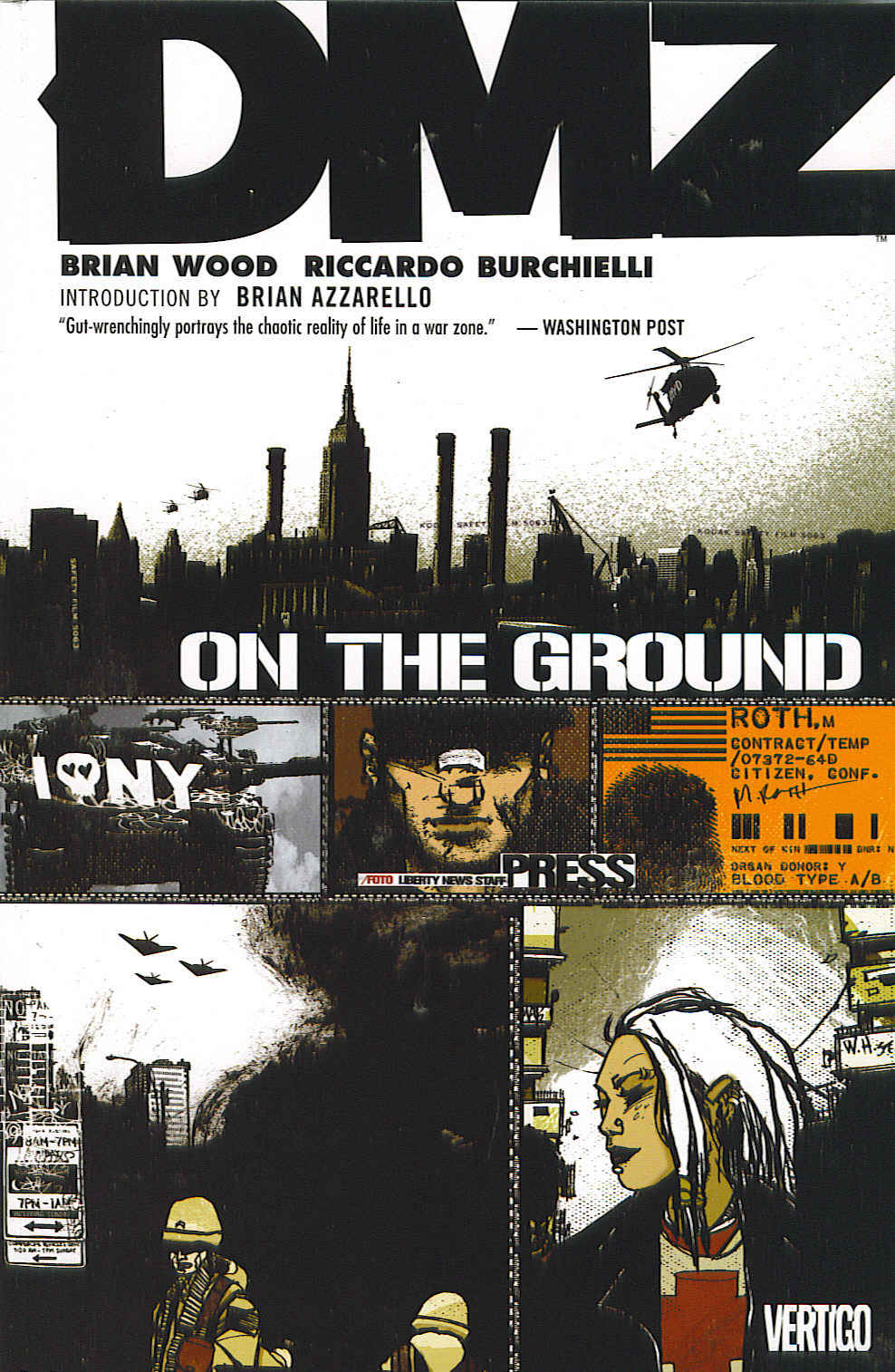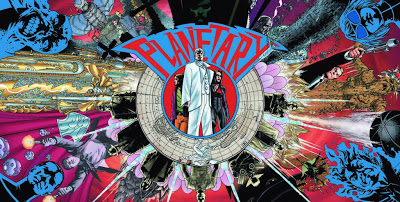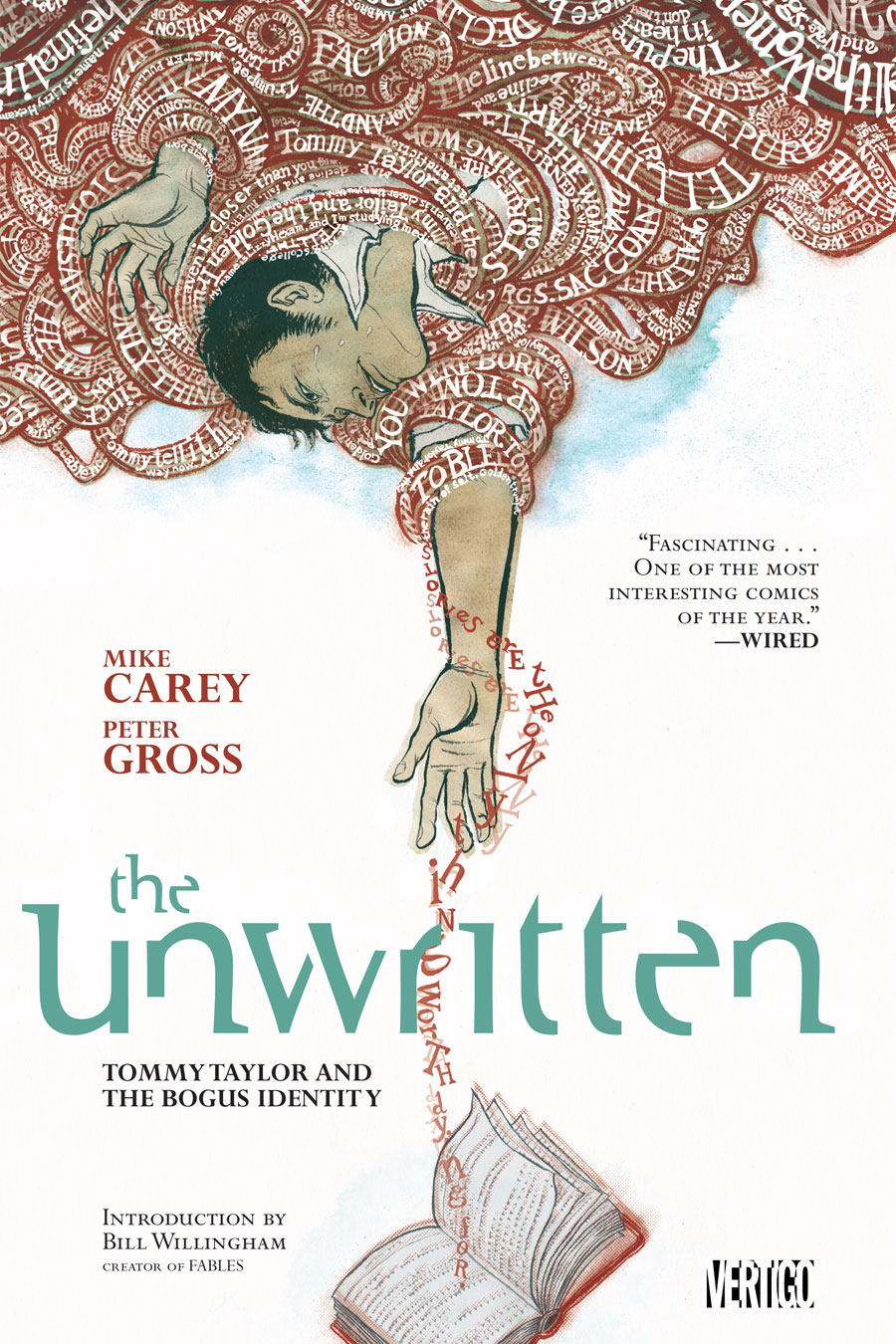Hello, my lovely Skiffys and Fantys!
I just got back from a delightful evening of talking about comic books at Atomic Books in Baltimore, so I was inspired to start a Geekomancer Under Glass sub-series about comic books. To start, I want to highlight some comics series outside the superhero genre. A lot of people still conflate comics with superheroes, but there’s incredible storytelling being done in the sequential art/graphic novel form outside the supers genre, in and out of SF/F. Hopefully, this series will expose people to some new titles and expand their horizons. It also gives Shaun a chance to come into the comments and tell me how I’m wrong about everything I say about comics. 🙂
DMZ
DMZ is a 12-volume speculative fiction series written by Brian Wood, art by Wood and Riccardo Burchielli (running 2005-2012). I say speculative fiction since the setting is an alternate present where the USA has fallen into a new Civil War, with the USA challenged by the Free States. As the series opens, the origins of the new civil war, and the exact ideological identity of the Free States are unclear, one of many elements that unfold throughout the series. I find that DMZ remains incredibly relevant in our current political climate, for a variety of reasons.
DMZ starts with the perspective of Matty Roth, an aspiring photojournalist who lands a once-in-a-lifetime gig to ride along on a visit to the DMZ, aka Manhattan. The former global-power city has become a Demilitarized Zone (DMZ) between Free States forces in New Jersey and United States forces in Brooklyn, Queens, and Long Island.
The reality of the DMZ as Roth discovers it is very different from the propaganda he’d been fed. The people in the DMZ are not only the poor and the sick, they’re also the people who refused to leave, who didn’t want to abandon their homes or their loved ones. Certain parts of the DMZ are utopian pseudo-collectives of neighbors helping one another, some are comprised of lone wolves looking out for themselves, others are held in an iron fist by gangsters, and so on.
Roth comes to identify with the people of the DMZ, and throws in with them, becoming the ultimate embedded reporter, but telling stories on his own terms. As the series goes on, it becomes more of an anthology series, broadening to show the perspectives of a variety of inhabitants in the DMZ, as well as going more into the new Civil War, the various factions’ reasons for wanting to control the DMZ, and so on.
Probably the most important thing that DMZ does, for me, is it brings 21st wartime to the USA. In the setting of DMZ Manhattan is re-turned from a high-status global city to a war zone. The city is constantly hammered by bombings, and vacillates between being fought over as strategic ground and written off as an externality. All the while, the residents of the city are ignored except when useful for propaganda’s sake. In a world where the US fights in seemingly endless conflicts on the other side of the world, where only warfighters and reporters see the reality of those conflicts up close, DMZ invites readers (and especially US Americans) to empathize with people whose worlds have been ruined and are constantly threatened by war.
Planetary
In the parallel world where I’m a recently-minted PhD, one of the classes I’d offer is “The Planetary Guide to 20th Century Pop Culture.” The class would use the comic series Planetary as an interpretive lens for examining 20th century pop/pulp genres (pulp, western, supers, golden age sci-fi, super-spy, Hong Kong action, etc.). Because for me, that’s what this series is – a way of re-interpreting a wide swath of 20th C. pop culture.
The series itself ran from 1999 to 2009, and I followed it month-to-month almost that entire run. There were big gaps in the publication history, with delays, other projects, and so on, which meant that the series spanned ten very formative years of my life, from ages 16-26.
In Planetary, 20th Century pop culture genres – pulp, superheroes, atomic horror, kaiju, etc., are all real. The protagonists, members of the Planetary Organization, are “Archaeologists of the Impossible,” discovering the secret history of the 20th century and fighting to keep the world strange and wonderful. For the first few issues, each episode focuses on a different genre, telling the story of a ghostly Hong Kong cop, betrayed and seeking vengeance, introducing a Golden Age pulp hero and his secret history as a savior of the earth, or sharing the tale of the survivor of a real-life 1950’s-style Atomic Science Fiction.
The full story is much larger and more magnificent, taking a knowing, deeply intertextual trip through 20th Century pop culture. Warren Ellis is one of my all-time favorite comics writers, and his partnership with John Cassaday on this series is simply incredible.
I highly recommend this series to any pop culture fan, especially if you are fond of re-interpretations of cultural history like Red Son, Astro City, or Soon I Will Be Invincible.
The Unwritten
The Unwritten is an ongoing Vertigo series by Mike Carey and Peter Gross (which some readers will recognize as the team behind the much-beloved Lucifer series). The Unwritten stars Tom Taylor, who was the namesake of Tommy Taylor, the star of a publishing global phenomenon — a la Harry Potter. Tom’s father, the author of the series, disappeared at the height of the series’ popularity, leaving Tom to work the convention circuit in his father’s absence.
When Tom’s world goes crazy in an Urban Fantasy kind of way, it becomes clear pretty quickly that William Taylor’s series is more than just stories in a set of books. The series that unfolds is a rich, thoughtful examination of the nature of celebrity and a public life, an interesting commentary on fantasy storytelling, and, more than anything, an investigation of the relationship between reality and stories. The art style does an excellent job of supporting the strong intertextual elements, with a ‘Tommy Taylor’ universe art style with impressive and distinct lettering. There are also entire sections of the comic where pages are given over to the text of one or another Tommy Taylor books.
One of my favorite parts of the series comes early on, where Tom Taylor ends up at a writing retreat for horror writers held at his father’s house. There’s great play with a group of horror writers across different sub-sets of the genre (urban noir, cosmic horror, splatterpunk, etc.). The metafiction cranks up a whole extra notch when the weekend turns into the plot of a slasher movie. These kinds of metatextual and intertextual turns are very common in the series, and make it a delight for readers who enjoy narratives that reward deep reading, re-reading, and intertextual interpolation and extrapolation.
These three barely scratch the surface of the wide world of non-superhero SF/F comics available today. What are some of your favorite SF/F comics going on today or from years past? I’m always game to add to Mount ToBeRead.











